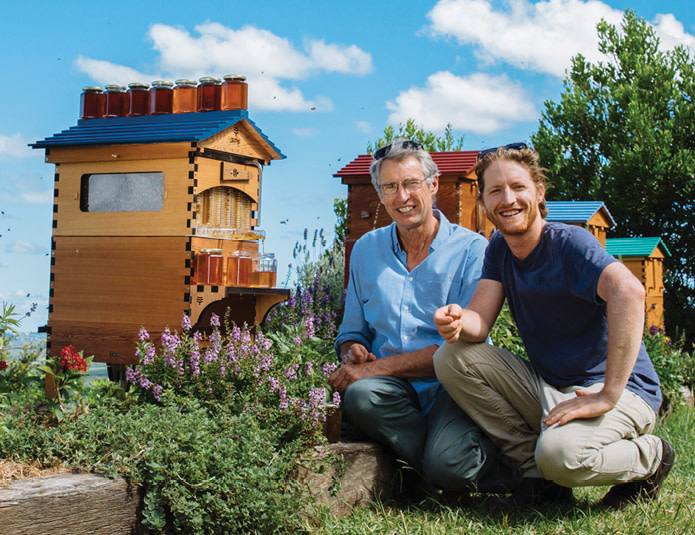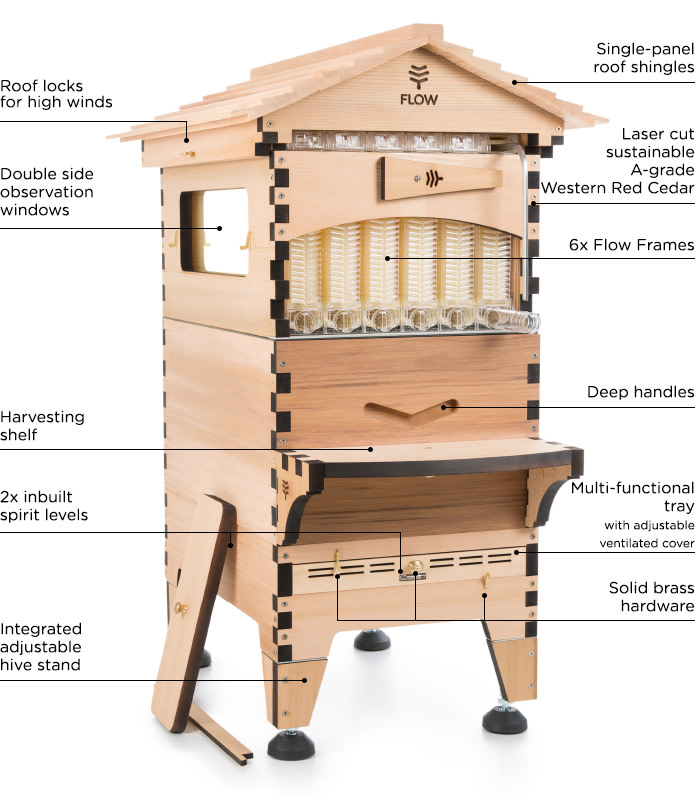How I Serve
I search for emerging companies, technologies, disruptive technologies, innovations, start-ups and up-starts. I’ll look to match potential problems… e.g. “plastic pollution” to solutions… e.g. 3D Printer for recycled plastic waste…for potential venture capitalists, angel investors, and online funders. I’ll also highlight a variety of topics including funding success stories, the environment, housing, medical, artificial intelligence, science, aging populations, disabled populations, social entrepreneurs, philanthropy, and topical news. I’m always searching for great people innovating, inventing, and doing, great things.
I don’t endorse. Only disseminate.
The 411: Investment Opportunity - Collect Fresh Honey Straight From the Hive
Found on: https://www.indiegogo.com/projects/flow-hive-2--2#/
https://www.honeyflow.com/
Flow Hive 2
Honey on tap directly from your beehive
PROJECT OWNER

Cedar and Stuart Anderson
Byron Bay, Australia

It’s hard to think of a more rewarding hobby than beekeeping. However, extracting honey from a conventional hive used to be a real labor of love:
 You’d have to suit up, smoke the bees, crack the hive open, lift out the frames, sweep off the bees, transport the frames to your honey shed, uncap each frame with a hot knife, stick the frames in a centrifuge, spin out the honey, filter out the wax and bee bits, fill your jars, take the empty frames back to the hive, open the hive again to replace them, then clean up all the mess. Phew!
You’d have to suit up, smoke the bees, crack the hive open, lift out the frames, sweep off the bees, transport the frames to your honey shed, uncap each frame with a hot knife, stick the frames in a centrifuge, spin out the honey, filter out the wax and bee bits, fill your jars, take the empty frames back to the hive, open the hive again to replace them, then clean up all the mess. Phew!
It was hot, sticky, heavy work, involving special equipment and lots of squashed bees.
Not anymore!
After a decade of tinkering, my dad Stu and I invented the beekeeper’s dream – the Flow Hive.

It’s so much easier for the beekeeper and so much gentler on the bees.
It makes harvesting honey as simple as turning a tap and watching as up to 4.5 lb (3kg) of pure fresh honey pours out into your jar from each Flow Frame. And because it’s completely unprocessed, it tastes amazingly good!
 “This has all come about because of our love for the bees and an acknowledgement of how important they are, not only to the food we eat, but to all life on Earth.”
“This has all come about because of our love for the bees and an acknowledgement of how important they are, not only to the food we eat, but to all life on Earth.”- Stuart Anderson

“If we look after the bees, they’ll look after us. And the honey really is an amazing bonus.”
- Cedar Anderson




Keeping bees is such a joyful and rewarding pastime. It gives you the opportunity to observe the interconnectedness of life, to appreciate the changing seasons in a new way, and to play an active role in contributing to the health of your environment.
As you get to know your bees, you’ll discover many fascinating aspects of their behaviour. You’ll start to notice little things like how they communicate with each other, the way they construct honeycomb, and which plants are in flower throughout the year. Plus, of course, there’s also the sweetness of having honey to share with your family and neighbours.
Embarking on your first foray into beekeeping can be daunting – there’s so much to learn. At one time or another everyone in Flow HQ was a nervous newbie, but we’ve all quickly grown to love beekeeping.
We’re here to help, so we’ve put together a swarm of educational materials and videos. With support from our friendly and knowledgeable team we’ll have you beekeeping with confidence in no time!
Our invention makes honey harvesting so much easier than ever before for both the bees and the beekeeper. This quick easy honey collection also means you have more time for other more enjoyable and necessary aspects of beekeeping, like checking the brood to make sure your girls are healthy.
“Ya know, I think the most interesting part about the honey coming out of the Flow Hive is the difference in each frame of honey.
And so, harvesting a frame of honey and just being able to smell it like a glass of wine and actually the floral notes are there. I mean, if you smell a bottle of honey that's been extracted, it just, it's not the same.”
- Jeff Walker, Texas
As bees tend to focus on filling one individual Flow Frame before moving on to the next, even within a single Flow Hive, the flavour will vary between frames depending on the forage available.
Flow technology allows those single origin flavours to shine through, while eliminating the incidental blending and the oxidation associated with conventional methods.
FLOW HIVE & BEEKEEPING BASICS:
What is a Flow Hive?
A Flow Hive is our complete beehive comprising of a brood box and Flow Super (which contains our patented Flow Frames), plus a roof and screened baseboard, inner cover and queen excluder. We may also refer to any beehive with at least one brood box and one or more Flow Supers for honey storage and harvest as a Flow Hive. A honeybee hive is usually made up of two boxes; the brood box where the queen bee lays eggs, and the ‘super’ with honeycomb for the storage of honey. A ‘Flow Super’ is a beehive box using Flow Frames that the bees store honey in.
What are Flow Frames?
“Flow” is the name of our revolutionary invention that allows honey to be harvested directly from the hive without opening the hive and with little disturbance to the bees. The Flow Frames are the honey storage frames for use in the super box that make this possible.
How do the Flow Frames work?
The Flow Frame consists of already partly formed honeycomb cells. The bees complete the comb with their wax, fill the cells with honey and cap the cells as usual. When you turn the Flow Key, the cells split vertically inside the comb forming channels, allowing the honey to flow down to a sealed trough at the base of the frame and out of the hive - a bit like a tap - while the bees are practically undisturbed on the comb surface.
When the honey has finished draining, you turn the Flow Key again in the upper slot, resetting the comb into the original position. The bees then sense the comb is empty, chew the wax capping away, and start to fill it with nectar again.
How are 2nd Generation Flow Frames different to the original Flow Frames?
Both our Flow Hive 2 and Flow Hive Classic come with generation 2 Flow Frames.
These contain lots of minor improvements for better functionality, durability and to further minimise any disturbance to the bees during harvest.
These include:
Adjustments in the cell depth of the moving comb blade, so the movement that forms channels through the comb happens deeper beneath the bees feet for minimal disturbance, this also allows the bees to draw out their comb further.
A decrease in the cell wall thickness results in a slight increase in the amount of honey that can be stored and harvested from each Flow Frame.
The central spine of the moving parts is now more robust offering more durability.
An increase in the reset and lift pressure from the Flow Key is added for better functionality.
Added radiuses and angles for easier insertion of the Flow Frames when beekeeping.
Some cosmetic rounded edges have been added on the front lower transparent end.
Tighter securing cables hold the frame together more securely.
Upper and lower frame caps now have a handle negating the need for pliers to remove.
How do I stop the bees getting to the honey while it's draining out of the Flow Hive?
Quite often we can drain the honey out without the bees even noticing us at the back of the hive, but sometimes they may be attracted to the honey and you will need to cover the jars, or better still, make a sealed system. This can be achieved by simply making a hole in the lid of a jar for a tube to go into. If you are using a bucket, you can put many holes through the lid of the bucket or make up a manifold.
Do the bees willingly fill the Flow Frames compared to conventional wax foundation?
The speed at which the bees fill the Flow Frames for the first time in comparison to conventional frames will vary greatly from colony to colony. Some bees will start to fill them quickly whilst other can take longer. There are many methods that can be used to encourage a slow colony to get working on the frames, see our FAQ here for further information. We have found that once the bees have completed the frames for the first time they no longer seem to show a preference either way and readily start building on, and filling the Flow Frames at the same time as the traditional ones.
How long does it take before I can drain the honey from the Flow Hive?This depends on the amount of nectar available in your region for the bees and how strong the colony is. Most colonies will need time to establish in the brood box before the Flow Super can be added to the hive, which can take weeks to months depending on the strength of the colony, method of installation, time of year and available forage. Once the super has been added to the hive and there is a good nectar flow available, progress can be pretty fast. We have had Flow Supers that have filled in one week during peak times of the flowering season, however, with a strong colony and good nectar source you can usually expect honey with a month or two.
How long does it take for the honey to drain out?
Anything from twenty minutes to over two hours depending on the temperature and the viscosity of the honey. It is even OK to leave it draining overnight (if it is secure from nocturnal animals). When you have finished draining the honey remember to return the frames to ‘closed cell’ position so that the bees can seal the broken cells and recommence filling them with more honey. We have designed it so the Flow Key cap only fits when the cells are in the closed position.
How much honey comes out of a Flow Hive?
About 5.5 - 6.5lbs per frame (2.5 - 3 kg), more if the bees really build each frame out. If you have seven frames in your Flow Super, then you can expect to harvest at least 45 lbs (20 kg) when every frame is full.
Can the Flow Frames come out of the super like standard frames do?
Yes. This is important for inspections, and how most hives in the world work. However, there is no need to remove the frames in the normal operation of extracting honey.
What extra equipment will I need to keep bees?
Though the Flow Hive makes harvesting honey easier, you will still need to open the hive to inspect its health as usual - for this you’ll need safety gear such as a bee suit, smoker and hive tool - available on our website. If you’re new to beekeeping, you should link up with an experienced beekeeper or join the Flow Community Forum to learn how to care for your bees.
How do I know when to harvest the Flow Frames?
The end of each Flow Frame is visible by taking the cover off at the rear of the Flow Super and this can give you a good indication of when the frames are full. It is worth having a look at the bees regularly through this window as you’ll get to observe your hive’s activity and it doesn’t disturb the bees. You will see the bees depositing nectar in the cells and, when the cells are full, evaporate it into honey and seal them with a wax capping. You can harvest from a frame as soon as you see that it is full, although there is no hurry - the sealed honey will keep until it is convenient for you to drain it out of the hive.
Do I need to smoke the Flow Hive?
Not when you are operating the Flow Frames or just viewing the bees. Smoke is usually used to calm the bees when the hive is opened. However, bees do react to the hive being jolted, so it’s a good idea to have a smoker on hand in case the bees do start getting aggressive. A little smoke puffed into the entrance of the hive and some puffed around the hive itself will tend to calm them down. You will still need a smoker when you do the routine inspection of the brood nest.
Do I need to wear a bee suit, bee veil or gloves when I drain the honey out?
We do recommend you wear a bee protective suit, especially if you are new to beekeeping or have a new, unknown hive. Some beekeepers just use a veil, as being stung on the face, particularly up the nose, is painful and inconvenient!
We have found we can work at the back of the hive without the bees seeming to notice our presence, however we highly recommend that you wear a bee suit or at least a veil until you get to know your bees.
Beekeeping is a labour of love. As with all animal husbandry, it’s a pastime which requires knowledge, skill and dedication and which carries with it inherent risks. Sooner or later, all beekeepers get stung. Some people have severe allergies to bee stings, so please be aware of the potential hazards when considering whether beekeeping is right for you.
Check out this Flow-sponsored safety pamphlet covering common beekeeping safety risks and first aid responses.
Is there a best time of day to drain the honey from a hive using Flow Frames?
It is possible to harvest from a Flow Hive at any time of the day or night because the hive is not opened. It is not uncommon for bees to beard out the front of the hive when harvesting (as with conventional harvesting), so it is important to note that if you are expecting a cold night it is best to harvest in the morning or during the day.
We have found the bees are calmest in the late afternoon, and at this time the honey in the hive is likely to be warmest and runs easily, therefore we tend to extract at this time.
How often do I need to check the brood?
This depends on your location. Please check with beekeepers in your local area for recommended inspection schedules. If the hive is weak or showing signs of decreased activity it should also be inspected. Our invention changes the honey harvesting component of beekeeping, however all other aspects of normal beekeeping care still apply; beetles, mites, swarm control etc. The Flow Super observation windows do assist with allowing you to look into the hive and gauge the strength and health of the colony, however, brood inspections are still required.
Do I need to leave some honey in the Flow Hive for the bees?
Yes, this applies to all beekeeping. Your bees need honey to get them through the times when there is no nectar available. The number of frames of honey that you leave depends on your climate. You should consult local beekeepers as to how much honey is required for overwinter.
The Flow Frames make it easier to see how much honey is in your frames at any time, so you can learn to manage how much honey to harvest and how much to leave for the bees. You can even partially harvest individual Flow Frames.
Watching the honey level change every day is quite fascinating and many beekeepers report that they can’t help but look on a daily basis.
Some beekeepers do need to feed their bees overwinter to help them get through the cold winter months; this will depend on local climatic conditions. It is important to seek guidance from experienced beekeepers in your region to learn about overwintering practices.
How do the bees know when to uncap the Flow Frames?
The bees are quick to notice when the cells are empty and set about uncapping it usually within 24-48 hours. They will then get to work repairing the cells in readiness to fill them with nectar, to turn into honey, again.
Can you harvest beeswax from a Flow Frame?
Honey comes out of the Flow Frames free from wax and ready for the table. Bees use about 7lb honey to make 1lb of wax, as they do not need to rebuild the comb in the Flow Frames, this generally means improved honey production. Consequently, it is not possible to harvest wax from Flow Frames, however, if you are interested in being able to harvest wax and Flow Honey, have a look at our Flow Hive Hybrid 3 frame (for the best of both worlds).
Do Flow Frames work with Australian native bees?
The Flow Frames are designed for use with the European Honey Bee, Apis Mellifera and cannot be used with Australian bees or on an Australian native bee hive. Australian Native bees have a completely different comb/pod structure and honey production pattern to the European honey bee.
Are the Flow Frames BPA-free?
Yes. The manufacturers have assured us that all plastic in the Flow Frames is not only BPA-free, but it is not manufactured with bisphenol-S or any other bisphenol compounds.
No comments:
Post a Comment